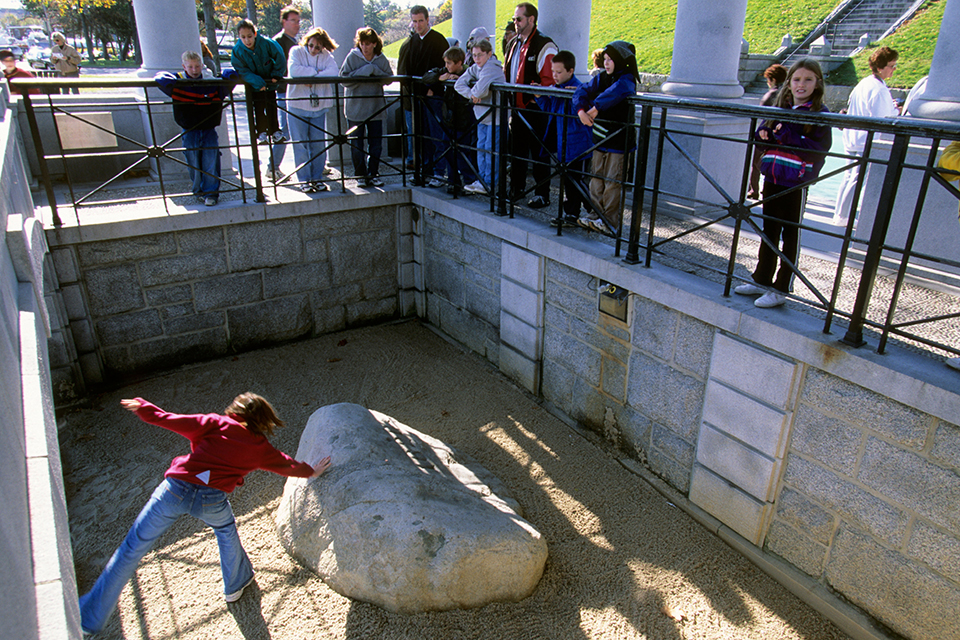IN 1620, THE PILGRIMS landed in what is now Plymouth, Massachusetts, and established what became the oldest permanent settlement in New England. After that, the story gets murky. What most Americans know about the Pilgrims is more fiction than fact. Much of the narrative—including the label “Pilgrims”—was made up by 18th and 19th century revisionists. In religious terms, the people now called Pilgrims were actually Puritan Separatists who called themselves “Saints” and members of other Protestant sects “Strangers.” They used less kind words for Catholics and followers of other faiths.
Plymouth Colony Governor William Bradford did refer to his group as “pilgrimes,” but only in the general sense. The Rev. Cotton Mather, an influential Puritan minister, employed that term in 1702. Mather, remembered for his prominent role in the Salem Witch Trials, was a prolific writer, authoring some 450 texts, including Magnalia Christi Americana, an ecclesiastical history of New England in which he names the Saints as Pilgrims—with a capital P. However, the term as used now did not enter the lexicon until 1820, when renowned orator Daniel Webster referred several times during a speech to the early settlers as “the Pilgrims.” Webster’s remarks, on the 200th anniversary of Plymouth’s founding, were reprinted in newspapers across the country.
Latecomers
Plimoth Plantation, as early Plymouth was called, was not the New World’s first English settlement. Jamestown, in Virginia, 13 years older, was abandoned in 1610 but reestablished soon after. The Roanoke Colony initially was established in what is now North Carolina in 1585, but within two years those settlers had vanished. Nor was Plimoth Plantation New England’s first immigrant settlement. The Popham Colony, in what is now Maine, took root in 1607. Within the year the Popham settlers had given up and returned to England. Spain founded North America’s first permanent European settlement in 1565: St. Augustine, Florida, is the continent’s oldest immigrant city, and likely the scene of the first real Thanksgiving. Evidence suggests that in September 1565 Spanish soldiers and civilians attended a mass of thanksgiving, then feasted with the local Timucuan tribe.
Not Upon This Rock
Did the Pilgrims really land at Plymouth Rock? Probably not. The anchorage at what the new arrivals called “Plimoth,” after the port from which they had sailed, was and is a large harbor protected by a narrow entrance that connects to a bay and estuary. However, Plymouth harbor, while safe from winter storms and easily defended, lacks depth. In 1620, the harbor was at most 13 feet deep, with few natural channels able to accommodate ocean-going vessels. The crew of Mayflower had to anchor offshore. The Pilgrims rowed or sailed ashore in a shallop, a small open boat drawing very little water. Even in a shallow-draft vessel, the immigrants likely had to debark and wade the last 100 yards or so. No primary source, including Edward Winslow’s Mourt’s Relation and William Bradford’s Of Plimouth Plantation, mentions a rock. The first reference to the waterside outcropping appears in the 1835 book History of the town of Plymouth, from its first settlement in 1620, to the present time, in which author James Thacher describes how in 1741 townspeople decided the rock, long a local landmark, stood in the way of a wharf project. The proposed solution: build over the boulder. Lifelong resident and church elder Thomas Faunce, 94, was taken to the stone in a chair to say his goodbyes, in which he claimed his father had told him the Pilgrims had stepped onto the rock upon arriving at Plimoth. According to Thacher, Faunce’s testimony so moved townsmen that they constructed the wharf around what quickly became known as Plymouth Rock. Thacher writes of being told this story by Deacon Ephraim Spooner, who as a youngster had been present when Faunce spoke out. Faunce the elder had not been present at the landing in 1620; he arrived in 1623. Faunce the younger, born in 1647, undoubtedly knew original settlers and may have heard the story from them. The oversize outcropping surely caught the newcomers’ attention, notes Donna Curtin, executive director of Pilgrim Hall Museum, the oldest continually operated museum in America. “It was described as the Great Rock in early 18th-century manuscripts,” she said. “The Rock was much larger then and certainly an unusual feature on the coastline. It is entirely feasible that the Pilgrims would have steered toward the Rock since it was the most visible thing on the shore, so we don’t throw out the whole story.”
Freedom, Sort Of
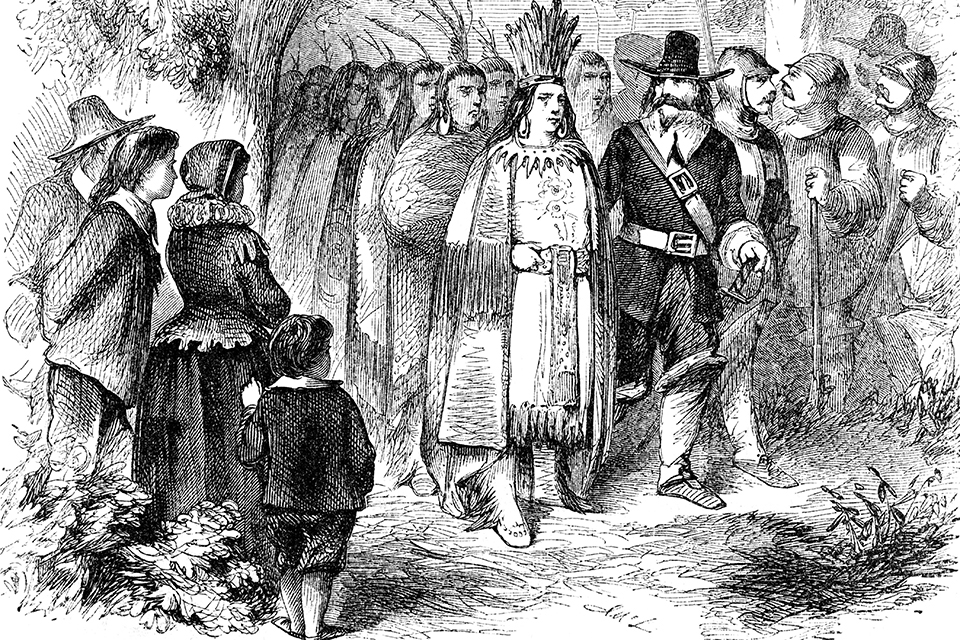
Did the Pilgrims come to the New World for religious freedom? The answer is complex. The Pilgrims wanted religious freedom, yes—for themselves. As Puritan Separatists, they believed the Church of England differed little from Roman Catholicism and therefore needed to be purified of its papist origins. Unable to change the state religion, the sect advocated “separating” from what they saw as England’s half-baked Protestantism to pursue the Saints’ more stringent beliefs. This stance set the Puritan Separatists on a collision course with English authority until the faction decamped in 1609 to libertine Holland, which let anyone worship as they pleased. However, Holland was not England, and the Pilgrims missed England and its culture even if its official church was romish. So they made plans to return home and then sail the western ocean, hoping to settle in Virginia. However, storms blew the Mayflower, carrying a 102-member complement of Separatists, merchants, indentured servants, and sailors, north to Cape Cod. Not all aboard believed in “purifying” the Church of England, but the Separatists set the pace, so everyone at Plimoth Plantation worshipped in the prescribed way. Toeing the Separatist line kept skeptics from being convicted by the settlement’s General Court and punished with flogging and perhaps banishment, as occurred in 1633 when the Pilgrims threw out minister Roger Williams for having “strange opinions.” Williams went on to found what is now Rhode Island, which became a haven for Baptists and other outcasts, like two men flogged and banished by their neighbors after being convicted in 1657 of being Quakers.
Wary Friendship
Another legend has Pilgrims befriending Native Americans, and vice versa. At best, the relationship was one of reluctant allies making use of one another in a precarious situation. The Pilgrims were trying to survive in a remote, hostile environment thousands of miles from support. That first winter, conditions wiped out half the plantation’s population. Food was scarce. Illness was rampant. The same was true for the local tribe, the Wampanoag, whose territory included Plimoth and whose population had shrunk 90 percent 1616-19 as a result of smallpox, leptospirosis, and other European diseases. The Wampanoag sachem, or leader, Ousamequin—better known as Massasoit—was caught between Plymouth Rock and a hard place. He saw that his depleted tribe could neither repel the Pilgrims nor go toe to toe with southern New England tribes like the Narragansett, whose lands lay to the west and with whom the Wampanoags had been warring. Massasoit understood that his tribe’s best chance for survival was to fend off rival tribes by forming a military alliance with the English settlers. Massasoit agreed to peace talks. He met with John Carver, Plimoth Plantation’s first governor, at William Bradford’s house. The sachem’s hosts gave him food and drink, including liquor, before the talks began. As a result of the colloquy, the Wampanoag agreed not to harm the Pilgrims and to provide them with military support if other tribes unjustly attacked the English. Both sides also agreed to leave their weapons behind when engaging in trade. Massasoit liked the settlers, one of whom saved his life by providing medicine and care when he was gravely ill. The Wampanoag leader worked hard to cultivate his foreign allies. In 1623, he warned the Pilgrims that the Massachusetts, a tribe to the north, were planning to attack Plimoth Plantation, and joined forces with the English for a preemptive strike against the plotters.
But the Pilgrim/Indian alliance was fraught with friction arising from cultural differences. The English made numerous deals to acquire parcels of land from the Wampanoag. Seeing land not as private property but a communal holding, the original inhabitants happily “sold” acreage, assuming they always would have use of it and all its resources. The result was a steady stream of conflict and complaint, including several occasions when Plimoth residents prosecuted Native Americans for “trespass”—an offense common among Pilgrims intruding on Indian lands. Initially, Pilgrims and Wampanoag aired grievances, then handed over parties found guilty to the other side for punishment. Eventually, the Native Americans were made subjects of the Plimoth Colony under English magistrates’ jurisdiction. Court rulings usually favored the English. However, in 1638 authorities executed colonists Arthur Peach, Thomas Jackson, and Richard Stinnings for murdering Native American Penowanyanquis.
Under this arrangement, the peace held for 50 years. With the deaths of Bradford and Massasoit, however, relations soured. Tension came to a head in 1675 when Massasoit’s son, Metacomet, began King Philip’s War, North America’s bloodiest conflict in ratio of deaths to population. The war ended with the Wampanoag virtually annihilated, Metacomet killed, and his head displayed on a pike for 25 years in front of the Pilgrim fort at Plymouth.
What First Thanksgiving?
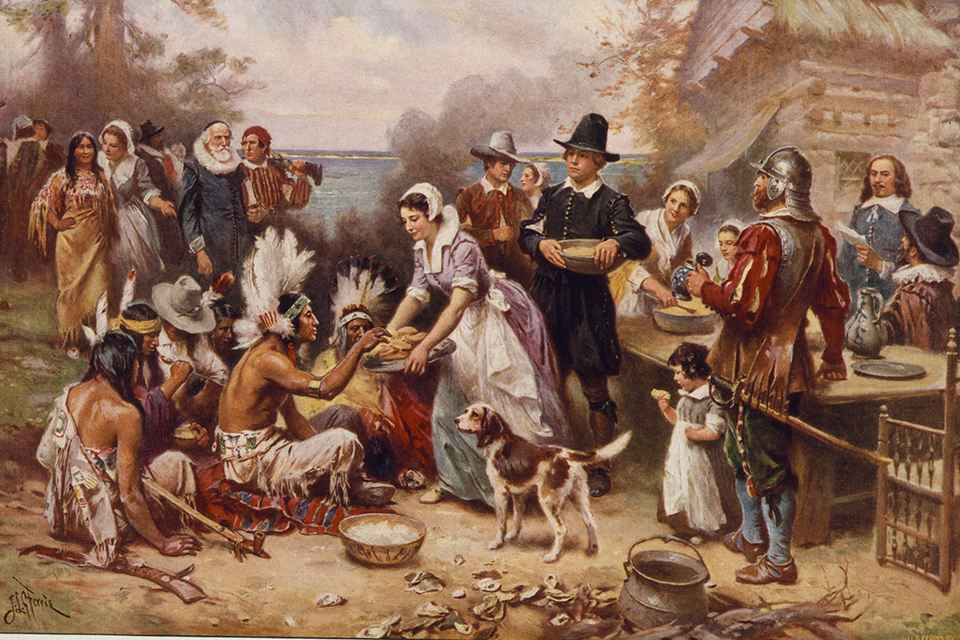
That first Thanksgiving in November 1621, Pilgrims and Indians, so happy together, carving the turkey, spooning heaps of mashed yams, watching football.
Yeaaaah… No.
“The first Thanksgiving was nothing like what most Americans believe,” said James Baker, Plymouth historian and author of several books about the Pilgrim myth. “It became much more ensconced in the American imagination over time.”
Plymouth residents did stage an autumn celebration in 1621, but neither Bradford’s Of Plimoth Plantation nor Winslow’s Mourt’s Relations specifically mention a service of thanksgiving. The settlement staged its first recorded Day of Thanksgiving—a religious observance—in 1623, to express appreciation for the arrival of much-needed rain. The celebration now recognized officially as Thanksgiving probably took place in September of that year, when Plimoth, hewing to English tradition, hailed the bringing in of crops. “Our harvest being gotten in, our governor sent four men on fowling, that so we might after a special manner rejoice together, after we had gathered the fruits of our labors,” Bradford wrote in his journal. “They four in one day killed as much fowl, as with a little help beside, served the company almost a week…” The three-day party included the Wampanoag, who contributed five deer to the larder. “By the goodness of God, we are so far from want, that we often wish you partakers of our plenty,” Bradford wrote. Did the feast include turkey, described earlier by Bradford as plentiful? Maybe, but no one says so in documents of the day.
The original scheduling of the holiday as the fourth Thursday in November occurred in 1789, when President George Washington in New York City, the young republic’s first capital, issued a Thanksgiving Proclamation. To show appreciation to God, Americans were to “unite in rendering unto him our sincere and humble thanks, for his kind care and protection of the People of this country previous to their becoming a Nation…” Washington said.
In the 1840s, Sarah Josepha Hale, a journalist and author of nursery rhyme “Mary Had a Little Lamb,” took up the cause. Hale petitioned four presidents to make a national holiday of Thanksgiving without success. In August 1863, however, following the epochal Civil War battle at Gettysburg, Pennsylvania, President Abraham Lincoln called for a National Thanksgiving. Hale wrote to the White House, urging the president to make “the day of our annual Thanksgiving…a National and fixed Union Festival.” That October Lincoln ordered an annual observance to commence on November 26 and thereafter take place on the final, and usually the fourth, Thursday of every November. Neither Hale’s letter nor Lincoln’s proclamation mentions the Pilgrims.
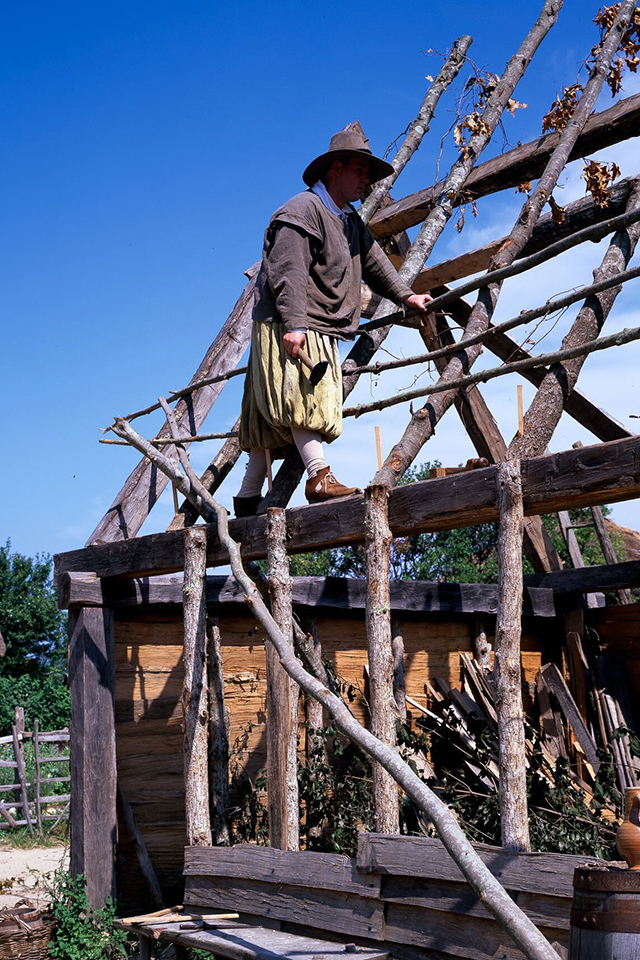
Thanksgiving entrenched itself soon after the Civil War. The popular image of the first holiday came largely from nativists promoting an “all-American” celebration in response to the arrival of immigrants in tones suggesting that the Pilgrims’ arrival was ordained on high. “The old elite was alarmed that these new cultural currents might overwhelm its traditional political and moral prominence,” Baker wrote in his 2009 book, Thanksgiving: The Biography of an American Holiday. “They believed that their beloved Anglo-Saxon Protestant heritage was threatened not only by crime, vice, and intemperance but also by…strange and frightening immigrant communities.” That movement set in motion the emergence across a 150-year span of today’s Thanksgiving, summed up by Norman Rockwell in his 1943 painting “Freedom from Want.”
Black on Black
Latter-day illustrations of the Pilgrims often show them wearing black—a notion traceable to Dutch painters of the late 1600s. who depicted wealthy clients in the finery of the day, which was black—expensive and therefore beyond the budgets of the generally impoverished Pilgrims. Fashion at Plimoth Plantation favored garments sewn from rough wool fabrics dyed in neutral colors set off by the occasional dull-red or dark-green accessory. And those iconic men’s belt-buckle hats? Nope. In keeping with the style of the day, male Pilgrims tended to wear wide-brimmed headgear.
Dorothy Bradford’s Demise
A tale persists that Dorothy Bradford, first wife of Plimoth Plantation’s second governor, was so overcome by despair that she threw herself off the Mayflower in Plimoth Harbor and drowned. Dorothy Bradford did die on December 7, 1620. However, in all likelihood, she was on an icy deck, lost her balance, slid overboard, and was dragged under when seawater saturated her heavy wool clothing. On a related front, Plymouth resident and Victorian novelist Jane G. Austin misled Americans in her novels by portraying the colony’s women as weak and vulnerable .Despite these and other popular representations, Pilgrim women were strong figures able to do the unrelenting work required of them.
And a Surprising Truth?
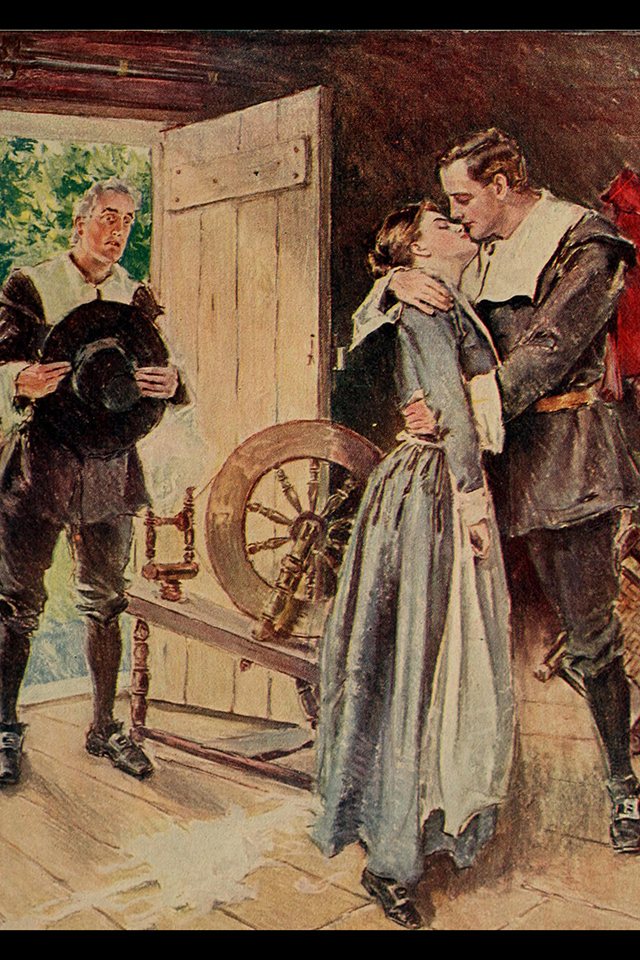
So did Pilgrim sweethearts John Alden and Priscilla Mullins really did hook up? Maybe. Centuries of interpretation and imagination obscure that romance, made famous by poet Henry Wadsworth Longfellow in his 1858 semi-epic “The Courtship of Miles Standish.” In the poem, the fair maiden famously says to her older suitor’s handsome young spokesman, “Why don’t you speak for yourself, John?”
In 1812, the Rev. Timothy Alden of Yarmouth, Massachusetts—a descendant of John Alden—wrote in his book American Epitaphs that generations of the Alden clan had been passing down the tale of John wooing Priscilla as oral history. Doubtless embellishments entered the narrative, but this myth may be based in fact. Miles Standish’s wife, Rose, had been among the fatalities at Plimoth Plantation that cruel winter of 1621. Popular custom frowned on public courting. The widower, seeking a bride, adhered to local mores and sent a representative to convince Priscilla Mullins of Standish’s interest. Standish’s man probably was Alden, believed to have been sharing a house with Standish.

